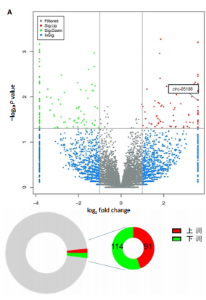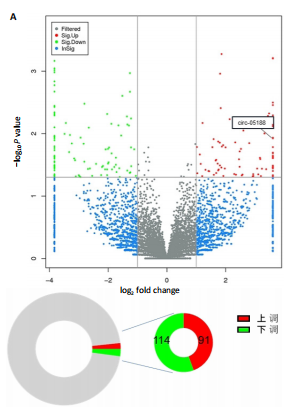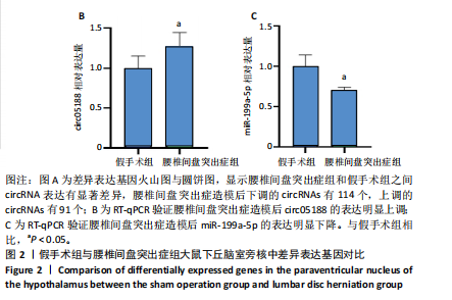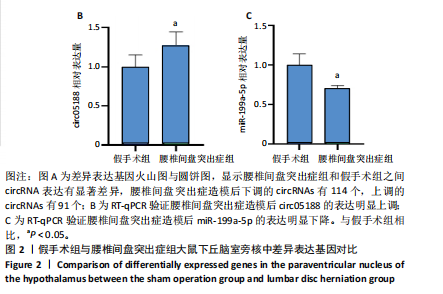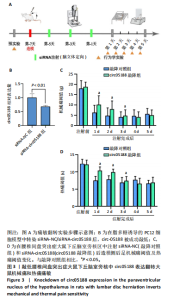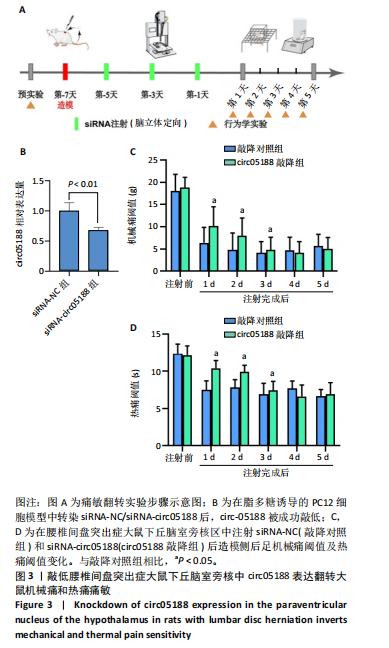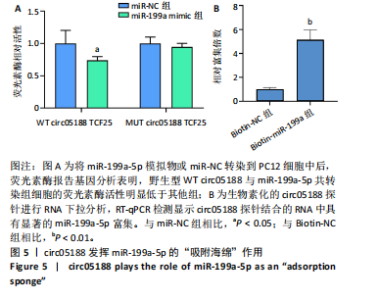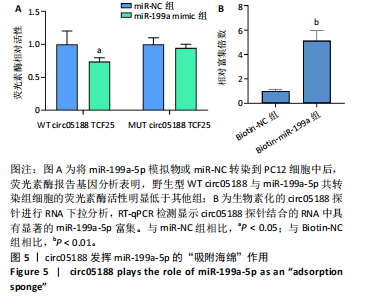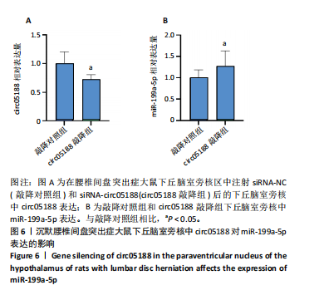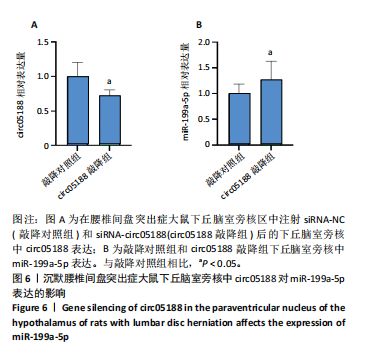Chinese Journal of Tissue Engineering Research ›› 2025, Vol. 29 ›› Issue (20): 4230-4238.doi: 10.12307/2025.705
Previous Articles Next Articles
Mechanism of circ05188 targeting miR-199a-5p involved in nociceptive hypersensitivity in a rat model of lumbar disc herniation
Wang Qianliang, Chen Jianpeng, Wang Yuanbin, Yan Jun
- Department of Orthopedics, The Second Affiliated Hospital of Soochow University, Suzhou 215004, Jiangsu Province, China
-
Received:2024-05-28Accepted:2024-08-21Online:2025-07-18Published:2024-12-20 -
Contact:Yan Jun, Chief physician, Department of Orthopedics, The Second Affiliated Hospital of Soochow University, Suzhou 215004, Jiangsu Province, China -
About author:Wang Qianliang, MS, Attending physician, Department of Orthopedics, The Second Affiliated Hospital of Soochow University, Suzhou 215004, Jiangsu Province, China -
Supported by:the National Natural Science Foundation of China, No. 81971036 (to YJ)
CLC Number:
Cite this article
Wang Qianliang, Chen Jianpeng, Wang Yuanbin, Yan Jun. Mechanism of circ05188 targeting miR-199a-5p involved in nociceptive hypersensitivity in a rat model of lumbar disc herniation[J]. Chinese Journal of Tissue Engineering Research, 2025, 29(20): 4230-4238.
share this article
Add to citation manager EndNote|Reference Manager|ProCite|BibTeX|RefWorks
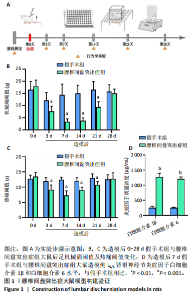
2.1 实验动物数量分析 52只SD大鼠全部进入结果分析。 2.2 验证大鼠腰椎间盘突出症模型构建成功 麻醉苏醒后大鼠均有蜷曲、少动的表现,但无瘫痪。造模后3 d部分大鼠出现跛行,左后肢无力症状。造模后第7天,假手术组和腰椎间盘突出症组大鼠相关症状均有所好转,直至造模后第28天,腰椎间盘突出症组大鼠运动能力完全恢复。 实验步骤示意图见图1A。腰椎间盘突出症组造模后第3,7,14和21天造模侧后足机械痛阈值、后足热痛阈值均低于假手术组(P < 0.05),其中造模后第7天差异最显著,见图1B,C。造模后第7天,腰椎间盘突出症组大鼠左侧L5/6背根神经节中促炎细胞因子白细胞介素1β和白细胞介素6水平均高于假手术组(P < 0.001),见图1D。 2.3 腰椎间盘突出症造模后circ05188表达升高和miR-199a-5p表达下降 为了研究circRNA在腰椎间盘突出症特异性痛敏中的调控作用,使用高通量测序检测腰椎间盘突出症造模后大鼠下丘脑室旁核中circRNA表达谱的变化。火山图结果表明,腰椎间盘突出症组和假手术组之间circRNA表达有显著差异,差异基因表达分析显示,腰椎间盘突出症造模后有91个上调circRNAs,114个下调的circRNAs,见图2A。腰椎间盘突出症造模后第7天,腰椎间盘突出症组circ05188表达高于假手术组(P < 0.05),见图2B。因此,猜测circ05188可能在腰椎间盘突出症特异性痛敏中发挥重要作用。造模后第7天RT-qPCR检测结果显示,腰椎间盘突出症组miR-199a-5p表达低于假手术组(P < 0.05),见图2C。 2.4 沉默circ05188能够缓解腰椎间盘突出症引起的神经性疼痛 为了进一步确定circ05188对腰椎间盘突出症特异性痛敏的调控作用,在腰椎间盘突出症大鼠下丘脑室旁核进行痛敏翻转实验。实验步骤示意图见图3A。首先将脂多糖处理的PC12细胞进行siRNA-circ05188转染,结果显示成功转染siRNA-circ05188,见图3B,再将筛选出的siRNA-circ05188序列经过化学修饰后进行SD大鼠脑立体siRNA注射。行为学检测结果显示,siRNA注射完成后第1,2,3天,circ05188敲降组大鼠造模侧后足机械痛阈值、后足热痛阈值均高于敲降对照组(P < 0.05),见图"
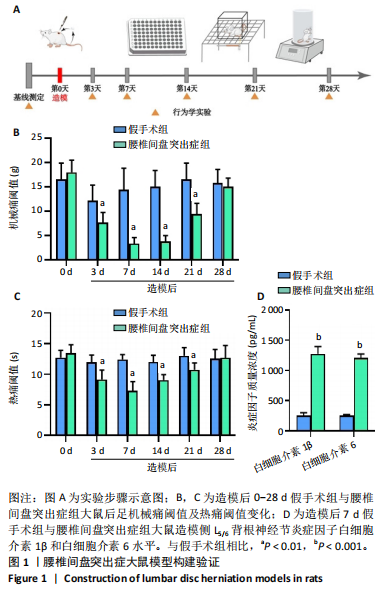
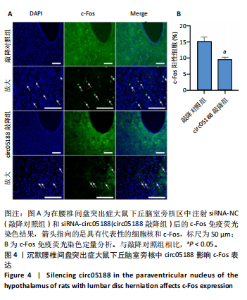
3C,D。说明脑内注射siRNA-circ05188能够有效缓解腰椎间盘突出症的机械痛敏和热痛敏。 2.5 沉默circ05188影响腰椎间盘突出症大鼠下丘脑室旁核c-Fos表达 室旁核是下丘脑的重要神经内分泌核团,诸多研究证实,室旁核广泛参与内脏痛、炎症痛和神经病理性疼痛的病理生理过程[31]。c-Fos是即刻早期基因编码的蛋白质,c-Fos表达上调通常见于神经元活动增强。连续3次在腰椎间盘突出症大鼠下丘脑室旁核行脑立体定位注射siRNA-NC和siRNA-circ05188后,注射完成后第3天,敲降对照组和circ05188敲降组大鼠下丘脑室旁核c-Fos表达产生差异变化,见图4A。c-Fos免疫荧光染色定量分析结果表明,circ05188敲降组大鼠下丘脑室旁核c-Fos阳性率低于敲降对照组(P < 0.05),见图4B。这一结果说明,敲低circ05188可以显著降低腰椎间盘突出症大鼠丘脑室旁核神经元活动性。"
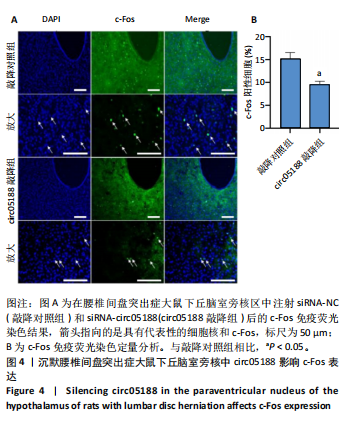
| [1] CIEZA A, CAUSEY K, KAMENOV K, et al. Global estimates of the need for rehabilitation based on the Global Burden of Disease study 2019: a systematic analysis for the Global Burden of Disease Study 2019. Lancet. 2021;396(10267):2006-2017. [2] RICKERS KW, PEDERSEN PH, TVEDEBRINK T, et al. Comparison of interventions for lumbar disc herniation: a systematic review with network meta-analysis. Spine J. 2021;21(10):1750-1762. [3] ZHANG AS, XU A, ANSARI K, et al. Lumbar Disc Herniation: Diagnosis and Management. Am J Med. 2023;136(7):645-651. [4] KNEZEVIC NN, CANDIDO KD, VLAEYEN JWS, et al. Low back pain. Lancet. 2021;398(10294):78-92. [5] CHOU R. Low Back Pain. Ann Intern Med. 2021;174(8):Itc113-itc128. [6] URITS I, BURSHTEIN A, SHARMA M, et al. Low Back Pain, a Comprehensive Review: Pathophysiology, Diagnosis, and Treatment. Curr Pain Headache Rep. 2019;23(3):23. [7] HORNUNG AL, BAKER JD, MALLOW GM, et al. Resorption of Lumbar Disk Herniation: Mechanisms, Clinical Predictors, and Future Directions. JBJS Rev. 2023;11(1).doi: 10.2106/JBJS.RVW.22.00148. [8] YU P, MAO F, CHEN J, et al. Characteristics and mechanisms of resorption in lumbar disc herniation. Arthritis Res Ther. 2022;24(1):205. [9] HAHNE AJ, FORD JJ, HINMAN RS, et al. Individualized functional restoration as an adjunct to advice for lumbar disc herniation with associated radiculopathy. A preplanned subgroup analysis of a randomized controlled trial. Spine J. 2017;17(3):346-359. [10] XU J, DING X, WU J, et al. A randomized controlled study for the treatment of middle-aged and old-aged lumbar disc herniation by Shis spine balance manipulation combined with bone and muscle guidance. Medicine (Baltimore). 2020;99(51):e23812. [11] WANG Y, HU H, YIN J, et al. TLR4 participates in sympathetic hyperactivity Post-MI in the PVN by regulating NF-κB pathway and ROS production. Redox Biol. 2019;24:101186. [12] JIANG Z, RAJAMANICKAM S, JUSTICE NJ. CRF signaling between neurons in the paraventricular nucleus of the hypothalamus (PVN) coordinates stress responses. Neurobiol Stress. 2019;11: 100192. [13] CHANG YT, CHEN WH, SHIH HC, et al. Anterior nucleus of paraventricular thalamus mediates chronic mechanical hyperalgesia. Pain. 2019;160(5):1208-1223. [14] LIU Y, LI A, BAIR-MARSHALL C, et al. Oxytocin promotes prefrontal population activity via the PVN-PFC pathway to regulate pain. Neuron. 2023;111(11):1795-1811.e1797. [15] ZHANG P, DAI M. CircRNA: a rising star in plant biology. J Genet Genomics. 2022;49(12):1081-1092. [16] ZHOU WY, CAI ZR, LIU J, et al. Circular RNA: metabolism, functions and interactions with proteins. Mol Cancer. 2020;19(1):172. [17] KRISTENSEN LS, JAKOBSEN T, HAGER H, et al. The emerging roles of circRNAs in cancer and oncology. Nat Rev Clin Oncol. 2022;19(3): 188-206. [18] CHEN LL. The expanding regulatory mechanisms and cellular functions of circular RNAs. Nat Rev Mol Cell Biol. 2020;21(8):475-490. [19] MISIR S, WU N, YANG BB. Specific expression and functions of circular RNAs. Cell Death Differ. 2022;29(3):481-491. [20] WANG X, ZHANG S, LV B, et al. Circular RNA PTP4A2 regulates microglial polarization through STAT3 to promote neuroinflammation in ischemic stroke. CNS Neurosci Ther. 2024;30(4):e14512. [21] CHEN T, WANG C, ZHU W, et al. mm9_circ_014683 regulates microglia polarization through canonical NFκB signaling pathway in diabetic retinopathy. Cell Signal. 2024;117:111121. [22] DIENER C, KELLER A, MEESE E. Emerging concepts of miRNA therapeutics: from cells to clinic. Trends Genet. 2022;38(6): 613-626. [23] VALI R, AZADI A, TIZNO A, et al. miRNA contributes to neuropathic pains. Int J Biol Macromol. 2023;253(Pt 4):126893. [24] SUMAIYA K, PONNUSAMY T, NATARAJASEENIVASAN K, et al. Cardiac Metabolism and MiRNA Interference. Int J Mol Sci. 2022;24(1):50. [25] CHEN W, XU J, WU Y, et al. The potential role and mechanism of circRNA/miRNA axis in cholesterol synthesis. Int J Biol Sci. 2023;19(9): 2879-2896. [26] DONG Q, HAN Z, TIAN L. Identification of Serum Exosome-Derived circRNA-miRNA-TF-mRNA Regulatory Network in Postmenopausal Osteoporosis Using Bioinformatics Analysis and Validation in Peripheral Blood-Derived Mononuclear Cells. Front Endocrinol (Lausanne). 2022;13:899503. [27] MADÈ A, BIBI A, GARCIA-MANTEIGA JM, et al. circRNA-miRNA-mRNA Deregulated Network in Ischemic Heart Failure Patients. Cells. 2023;12(21):2578. [28] DENG W, CHEN J, WANG X, et al. Paravertebrally-Injected Multifunctional Hydrogel for Sustained Anti-Inflammation and Pain Relief in Lumbar Disc Herniation. Adv Healthc Mater, 2024:e2401227. doi: 10.1002/adhm.202401227. [29] RUYLE BC, LIMA-SILVEIRA L, MARTINEZ D, et al. Paraventricular nucleus projections to the nucleus tractus solitarii are essential for full expression of hypoxia-induced peripheral chemoreflex responses. J Physiol. 2023;601(19):4309-4336. [30] DHALIWAL HK, FAN Y, KIM J, et al. Intranasal Delivery and Transfection of mRNA Therapeutics in the Brain Using Cationic Liposomes. Mol Pharm. 2020;17(6):1996-2005. [31] LIANG SH, ZHAO WJ, YIN JB, et al. A Neural Circuit from Thalamic Paraventricular Nucleus to Central Amygdala for the Facilitation of Neuropathic Pain. J Neurosci. 2020;40(41):7837-7854. [32] KREINER DS, MATZ P, BONO CM, et al. Guideline summary review: an evidence-based clinical guideline for the diagnosis and treatment of low back pain. Spine J. 2020;20(7):998-1024. [33] BAILLY F, TROUVIN AP, BERCIER S, et al. Clinical guidelines and care pathway for management of low back pain with or without radicular pain. Joint Bone Spine. 2021;88(6):105227. [34] LONG F, LI L, XIE C, et al. Intergenic CircRNA Circ_0007379 Inhibits Colorectal Cancer Progression by Modulating miR-320a Biogenesis in a KSRP-Dependent Manner. Int J Biol Sci. 2023;19(12):3781-3803. [35] ZHANG S, WANG X, CHEN G, et al. CircRNA Galntl6 sponges miR-335 to ameliorate stress-induced hypertension through upregulating Lig3 in rostral ventrolateral medulla. Redox Biol. 2023;64:102782. [36] JU J, SONG YN, CHEN XZ, et al. circRNA is a potential target for cardiovascular diseases treatment. Mol Cell Biochem. 2022;477(2): 417-430. [37] MOHANAPRIYA R, AKSHAYA RL, SELVAMURUGAN N. A regulatory role of circRNA-miRNA-mRNA network in osteoblast differentiation. Biochimie. 2022;193:137-147. [38] ALTESHA M A, NI T, KHAN A, et al. Circular RNA in cardiovascular disease. J Cell Physiol. 2019;234(5):5588-5600. [39] HUANG W, WU Y, QIAO M, et al. CircRNA-miRNA networks in regulating bone disease. J Cell Physiol. 2022;237(2):1225-1244. [40] ZANG J, LU D, XU A. The interaction of circRNAs and RNA binding proteins: An important part of circRNA maintenance and function. J Neurosci Res. 2020;98(1):87-97. [41] WU C, WANG S, CAO T, et al. Newly discovered mechanisms that mediate tumorigenesis and tumour progression: circRNA-encoded proteins. J Cell Mol Med. 2023;27(12):1609-1620. [42] MA B, WANG S, WU W, et al. Mechanisms of circRNA/lncRNA-miRNA interactions and applications in disease and drug research. Biomed Pharmacother. 2023;162:114672. [43] KAMEDA S, OHNO H, SAITO H. Synthetic circular RNA switches and circuits that control protein expression in mammalian cells. Nucleic Acids Res. 2023;51(4):e24. [44] WANG W, LIU C, HE D, et al. CircRNA CDR1as affects functional repair after spinal cord injury and regulates fibrosis through the SMAD pathway. Pharmacol Res. 2024;204:107189. [45] TONG D, ZHAO Y, TANG Y, et al. Circ-Usp10 promotes microglial activation and induces neuronal death by targeting miRNA-152-5p/CD84. Bioengineered. 2021;12(2):10812-10822. |
| [1] | Yu Jingbang, Wu Yayun. Regulatory effect of non-coding RNA in pulmonary fibrosis [J]. Chinese Journal of Tissue Engineering Research, 2025, 29(8): 1659-1666. |
| [2] | Lyu Liting, Yu Xia, Zhang Jinmei, Gao Qiaojing, Liu Renfan, Li Meng, Wang Lu. Bibliometric analysis of research process and current situation of brain aging and exosomes [J]. Chinese Journal of Tissue Engineering Research, 2025, 29(7): 1457-1465. |
| [3] | Yu Qinghe, Cai Ziming, Wu Jintao, Ma Pengfei, Zhang Xin, Zhou Longqian, Wang Yakun, Lin Xiaoqin, Lin Wenping. Vanillic acid inhibits inflammatory response and extracellular matrix degradation of endplate chondrocytes [J]. Chinese Journal of Tissue Engineering Research, 2025, 29(30): 6391-9397. |
| [4] | Fan Jiaxin, Jia Xiang, Xu Tianjie, Liu Kainan, Guo Xiaoling, Zhang Hui, Wang Qian . Metformin inhibits ferroptosis and improves cartilage damage in osteoarthritis model rats [J]. Chinese Journal of Tissue Engineering Research, 2025, 29(30): 6398-6408. |
| [5] | Zhou Ying, Tian Yong, Zhong Zhimei, Gu Yongxiang, Fang Hao. Inhibition of tumor necrosis factor receptor associated factor 6 regulates mTORC1/ULK1 signaling and promotes autophagy to improve myocardial injury in sepsis mice [J]. Chinese Journal of Tissue Engineering Research, 2025, 29(30): 6434-6440. |
| [6] | Wang Wanchun, , Yi Jun, Yan Zhangren, Yang Yue, Dong Degang, Li Yumei. 717 Jiedu Decoction remodels homeostasis of extracellular matrix and promotes repair of local injured tissues in rats after Agkistrodon halys bite [J]. Chinese Journal of Tissue Engineering Research, 2025, 29(30): 6457-6465. |
| [7] | Zhang Xin, Guo Baojuan, Xu Huixin, Shen Yuzhen, Yang Xiaofan, Yang Xufang, Chen Pei. Protective effects and mechanisms of 3-N-butylphthalide in Parkinson’s disease cell models [J]. Chinese Journal of Tissue Engineering Research, 2025, 29(30): 6466-6473. |
| [8] | Zhang Songjiang, Li Longyang, Zhou Chunguang, Gao Jianfeng. Central anti-inflammatory effect and mechanism of tea polyphenols in exercise fatigue model mice [J]. Chinese Journal of Tissue Engineering Research, 2025, 29(30): 6474-6481. |
| [9] | Hu Shujuan, Liu Dang, Ding Yiting, Liu Xuan, Xia Ruohan, Wang Xianwang. Ameliorative effect of walnut oil and peanut oil on atherosclerosis [J]. Chinese Journal of Tissue Engineering Research, 2025, 29(30): 6482-6488. |
| [10] | Zhang Jian, Cai Feng, Li Tingwen, Ren Pengbo. Fatigue gait recognition of athletes based on fish swarm algorithm [J]. Chinese Journal of Tissue Engineering Research, 2025, 29(30): 6489-6498. |
| [11] | Zhang Zihan¹, Wang Jiaxin¹, Yang Wenyi², Zhu Lei¹. Regulatory mechanism of exercise promoting mitochondrial biogenesis in skeletal muscle [J]. Chinese Journal of Tissue Engineering Research, 2025, 29(30): 6499-6508. |
| [12] | Wang Jianxu, Dong Zihao, Huang Zishuai, Li Siying, Yang Guang. Interaction between immune microenvironment and bone aging and treatment strategies [J]. Chinese Journal of Tissue Engineering Research, 2025, 29(30): 6509-6519. |
| [13] | Zhang Bochun, Li Wei, Li Guangzheng, Ding Haoqin, Li Gang, Liang Xuezhen, . Association between neuroimaging changes and osteonecrosis: a large sample analysis from UK Biobank and FinnGen databases [J]. Chinese Journal of Tissue Engineering Research, 2025, 29(30): 6574-6582. |
| [14] | Xu Zhi, Chen Yundong, Sun Yujie, Gong Xiaonan, Li Yuwan. Data of spinal osteosarcoma patients in United States based on SEER database: construction and validation of a prediction model for treatment outcomes and prognosis [J]. Chinese Journal of Tissue Engineering Research, 2025, 29(30): 6583-6590. |
| [15] | Zhao Xiaoxuan, Liu Shuaiyi, Xing Zheng, Li Qingwen, Chu Xiaolei, Li Qi. Research hotspots and trends in application of tissue engineering in peripheral nerve injury [J]. Chinese Journal of Tissue Engineering Research, 2025, 29(30): 6591-6600. |
| Viewed | ||||||
|
Full text |
|
|||||
|
Abstract |
|
|||||
